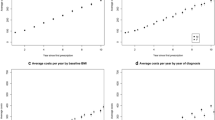Abstract
Aim
To identify how the electronic health record (EHR) systems and national registers can be used for research purposes. We focused on how the primary care physicians adhere to clinical guidelines.
Methods
Study population included incident type 2 diabetes patients from four selected regions. Data were collected in two phases. At the first phase study cohort was identified using the prescription registers of the Social Insurance Institution (SII) and EHR systems used within the study regions. At second phase, data were collected from SII’s registers, local EHR systems, the hospital discharge and the primary care registers of National Institute for Health and Welfare.
Results
Metformin was the most common choice as first drug. Among all study patients, 8375 (76.0%) started metformin monotherapy or combinations. The treatment was intensified at variable levels of HbA1c depending on the area. DPP4-inhibitors were by far the most common agent for treatment intensification. Sulphonylureas were used less often than basal insulin as the second-line agent. The use of DPP4-inhibitors increased between years 2009–2010, when first DPP4-inhibitor received reimbursement and this class became dominant drug for treatment intensification increasingly thereafter.
Conclusions
The EHR systems and national registers can be used for research purposes in Finland. The realization of diabetes treatment national guidelines are followed in primary care to a large extent. However, the subsequent intensification of therapy was delayed and occurred at elevated Hba1c levels.


Similar content being viewed by others
References
Holman RR, Paul SK, Bethel MA et al (2008) 10-year follow-up of intensive glucose control in type 2 diabetes. N Engl J Med 359:1577–1589
Advance Study Group (2016) Nine-year effects of 3.7 years of intensive glycemic control on cardiovascular outcomes. Diabetes Care 39:701–708
Zoungas S, de Galan BE, Ninomiya T et al (2009) Combined effects of routine blood pressure lowering and intensive glucose control on macrovascular and microvascular outcomes in patients with type 2 diabetes: new results from the ADVANCE trial. Diabetes Care 32:2068–2074
Gæde P, Oellgaard J, Carstensen B et al (2016) Years of life gained by multifactorial intervention in patients with type 2 diabetes mellitus and microalbuminuria: 21 years follow-up on the Steno-2 randomised trial. Diabetologia 59:2298–2307
Tancredi M, Rosengren A, Svensson AM et al (2015) Excess mortality among persons with type 2 diabetes. N Engl J Med 373:1720–1732
Working group set up by the Finnish Medical Society Duodecim and the Finnish Society of Internal Medicine and the Medical Advisory Board of the Finnish Diabetes Society. Diabetes. Current Care Guidelines http://www.kaypahoito.fi/web/english/guidelineabstracts/guideline. Assessed 2016
Gerstein HC, Miller ME, Genuth S et al (2011) Long-term effects of intensive glucose lowering on cardiovascular outcomes. N Engl J Med 364:818–828
Inzucchi SE, Bergenstal RM, Buse JB, American Diabetes Association (ADA), European Association for the Study of Diabetes (EASD) et al (2012) Management of hyperglycemia in type 2 diabetes: a patient-centered approach: position statement of the American Diabetes Association (ADA) and the European Association for the Study of Diabetes (EASD). Diabetes Care 35:1364–1379
Ngsp.org. (2018) NGSP. IFCC Standardization Overview. http://www.ngsp.org/ifcc.asp. Accessed 18 June 2018
Encepp.eu. (2018). ER12-9451 Realization of the clinical practice guidelines for diabetes in Finland—a case study of the usability of electronic patient information systems and national registers to support evidence based decision making in health care. http://www.encepp.eu/encepp/viewResource.htm?id=14809. Accessed 18 June 2018
Nomesko (2017) Health Statistics for the Nordic Countries 2017, 1st edn. NOMESCO-NOSOSCO, Copenhagen, p 238. http://urn.kb.se/resolve?urn=urn:nbn:se:norden:org:diva-4982. Accessed 20 Feb 2018
Heintjes EM, Overbeek JA, Hall GC et al (2017) Factors associated with type 2 diabetes mellitus treatment choice across four european countries. Clin Ther 39:2296–2310
Lipska KJ, Yao X, Herrin J, McCoy RG et al (2017) Trends in Drug Utilization, Glycemic Control, and Rates of Severe Hypoglycemia, 2006–2013. Diabetes Care 40:468–475
Overbeek JA, Heintjes EM, Prieto-Alhambra D et al (2017) Type 2 diabetes mellitus treatment patterns across Europe: a population-based multi-database Study. Clin Ther 39:759–770
Author information
Authors and Affiliations
Corresponding author
Ethics declarations
Conflict of interest
The authors declare conflicts of interest regarding this manuscript as follows: Leo Niskanen—no conflicts of interest regarding this manuscript. Hahl, Jarmo -Epid Research Ltd, Payment for contributing. Leppä, Elli—No conflict of interest. Miettinen, Tatu—Epid Research Ltd, Payment for contributing. Mushnikov, Vasili—Pharma Industry Finland, Payment to Epid Research Ltd. Jari Haukka, Vasili Mushnikov, Pia Vattulainen and Pasi Korhonen work for EPID Research. EPID Research is a contract research organization and thus its employees have been and currently are working in collaboration with several pharmaceutical companies.
Human and Animal Rights
The whole study plan was approved by the Ethical Review Board of Helsinki University Hospital (HUS May 2013).
Informed consent
This is a register-based study with anonymous data and no patient contacts. Thus no consents from anonymized patients were required according to Finnish law.
Additional information
Managed by Massimo Federici.
Electronic supplementary material
Below is the link to the electronic supplementary material.
Rights and permissions
About this article
Cite this article
Niskanen, L., Hahl, J., Haukka, J. et al. Type 2 diabetes and treatment intensification in primary care in Finland. Acta Diabetol 55, 1171–1179 (2018). https://doi.org/10.1007/s00592-018-1199-7
Received:
Accepted:
Published:
Issue Date:
DOI: https://doi.org/10.1007/s00592-018-1199-7




